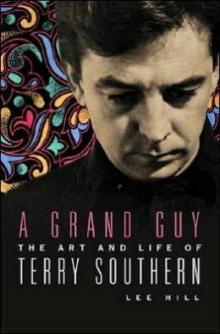A Grand Guy: The Art and Life of Terry Southern 

by Lee Hill
Genre: Other9
Published: 2002
View: 2104
Read OnlineRead A Grand Guy: The Art and Life of Terry Southern Storyline:
Terry Southern was integral to the avant-garde in postwar Paris, the Beat Years, swinging London, New York and Hollywood in the psychedelic sixties. He wrote the screenplays for "Easy Rider", "Dr Strangelove" and "Barbarella", suggested to Stanley Kubrick that the film "A Clockwork Orange", and created some of the most enduring landmarks of popular culture. "A Grand Guy" tells Southern's story - from his experiences during the Second World War to his appearance on the cover of "Sgt Pepper", from the lecture halls and jazz clubs of 1940s Paris to touring Texas with the Rolling Stones - providing a fresh portrait of one of the most enigmatic icons of the twentieth century.From Publishers WeeklyIn 1964, Southern was on the crest of celebrity. Not only had his underground 1959 novel, Candy (published by Olympia Press in Paris), been launched in the U.S., landing high on the bestseller list, but his screenplay for Stanley Kubrick's Dr. Strangelove was critically and commercially celebrated as a comic masterpiece. Today, Candy is a cult book and Dr. Strangelove is a classic. This well-researched and thoughtful biography is the first full life of the writer, whose novels never achieved the fame of his screenplays. Born in 1924 to an impoverished professional family in Texas, Southern left college and joined the army in 1943; later, on the G.I. bill, he studied in Paris, where he became a minor, if central, player in the literary expatriate scene there. Back in the U.S. in 1953, Southern moved to Greenwich Village and "embraced the emerging idea of Hip." Hanging out with artists like Robert Frank and Larry Rivers, he began shaping his public persona and a writing career that embodied that concept. His novels Flash and Filigree (1958) and The Magic Christian (1959) earned him a small, faithful literary following. But after 1964, Southern's career stalled. Despite work on high-profile film projects like Easy Rider and Casino Royale, Southern's essentialist hipster sensibility did not readily translate to screen or novel. Hill's unpacking of Southern's complicated history should please those who remember his work fondly, but the level of detail will probably keep other readers away. Copyright 2001 Cahners Business Information, Inc.From Library JournalSouthern's heyday was in the 1960s, when his screenplays for the films Dr. Stranglove, Barbarella, and Easy Rider were the height of cool. Born in Texas in 1924, Southern had a common rural childhood. After a stint in the army, he studied at Northwestern and then the Sorbonne. He explored the drugs, cheap cafes, music, and eroticism of Paris, where Candy was published in 1958 and quickly became a cult hit. Though initially banned in the United States, copies trickled in, and it was finally published here in 1964. It is his screenwriting credits in the 1960s that launched him into the pantheon of celebrity and found him hobnobbing with the Beatles and Stanley Kubrick. But, though his satirical edge influenced such programs as Saturday Night Live and The Larry Sanders Show, Southern's star waned. This biography falls curiously flat, given that its subject wrote some of the zaniest, most influential avant-garde pieces of his day. Journalist Hill, who interviewed Southern, offers no real analysis of how this seemingly ordinary Texan became the epitome of 1960s cool. For larger public and academic libraries. Rosellen Brewer, Monterey Cty. Free Libs., Salinas, CA Copyright 2001 Reed Business Information, Inc.Pages of A Grand Guy: The Art and Life of Terry Southern :